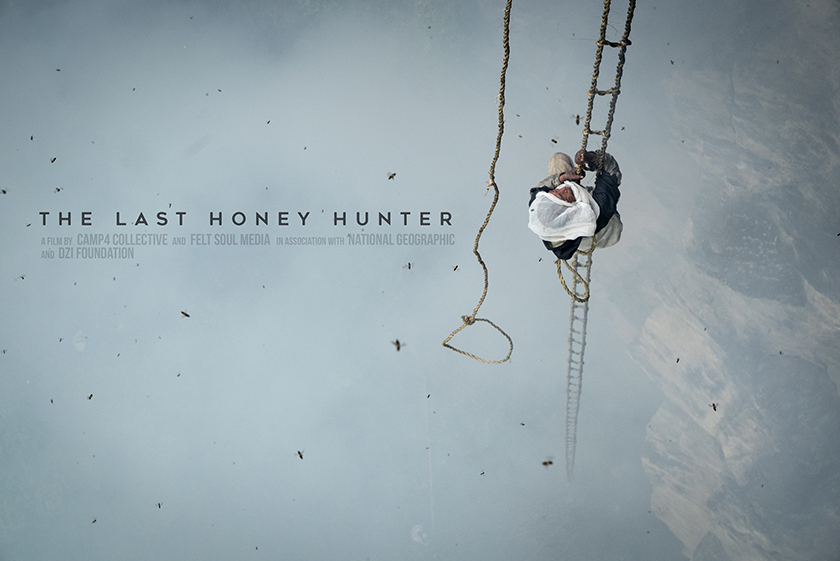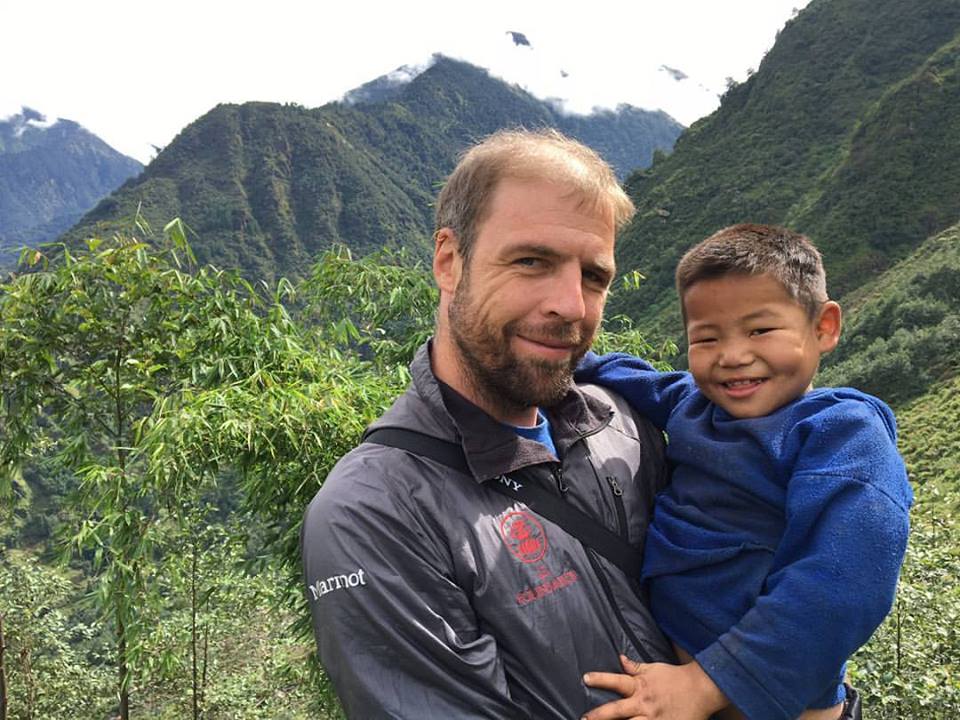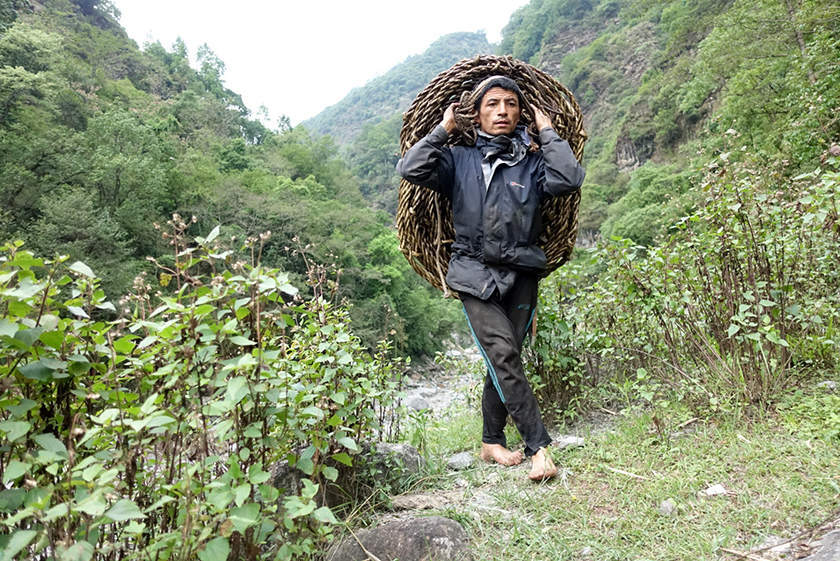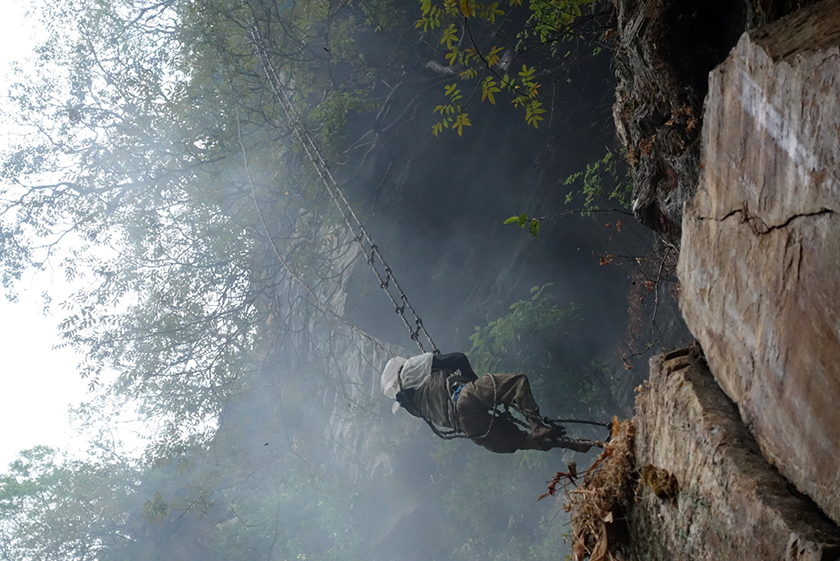 The ancient practice of honey hunting in Nepal first became famous decades ago through the work of Eric Valli. Recently a video has been making the rounds on Facebook and YouTube. Many have seen – and shared – the captivating footage of a man climbing up a sheer cliff on a rope ladder, his face swollen from bee stings. Ben Ayers is the producer of that film. He says the real story, the one he is more proud of, is about the honey hunter’s life away from the cliff, in the village, in his daily struggles that many rural Nepali experiences. Ayers told Kapil Bisht about how he found the story and why he wanted to tell it.
The ancient practice of honey hunting in Nepal first became famous decades ago through the work of Eric Valli. Recently a video has been making the rounds on Facebook and YouTube. Many have seen – and shared – the captivating footage of a man climbing up a sheer cliff on a rope ladder, his face swollen from bee stings. Ben Ayers is the producer of that film. He says the real story, the one he is more proud of, is about the honey hunter’s life away from the cliff, in the village, in his daily struggles that many rural Nepali experiences. Ayers told Kapil Bisht about how he found the story and why he wanted to tell it.
How did you get to know Mauli Dhan?
My relationship with Mauli Dhan and the community of Saadi [Mauli’s village] began some nine years ago. I was there working with the dZi Foundation. I was visiting some projects there. I happened to be there one night when a woman gave birth to twins. The first child was healthy, but there were complications while birthing the second child and the mother died. Being the kuire in the village, everyone came to me to see if I had any medicines or if I could help. Of course, I didn’t.
But I went through that sad experience with the village. The woman was Mauli’s sister-in-law. I first met Mauli during that traumatic situation. I developed a bond with the child that survived and through him with the village of Saadi. In the subsequent years as I continued to work there with the dZi Foundation and do projects there – drinking water project, rebuilding the school – I continued to travel there and going back to check on the kid. I also went there to visit the villagers because we had developed a bond.
Seven years ago, I happened to be in Saadi on the day that Mauli and his team of honey hunters were going on the honey harvest. They didn’t want me anywhere near the cliffs—for safety reasons but also because they feared that I wouldn’t be accepted by Rongkemi [the forest spirit that the Kulungs believe controls the forest, including the cliffs with the beehives].

I watched the harvest from a distance and it was the most incredible thing I had ever seen humans do. These guys were up on this cliff that was 300 feet high. And they were doing it without climbing ropes!
But I watched the harvest from a distance and it was the most incredible thing I had ever seen humans do. These guys were up on this cliff that was 300 feet high. And they were doing it without climbing ropes! I am a rock climber. These guys were doing hardcore rock climbing, surrounded by a hundred thousand bees, to get to these massive beehives. I was just totally blown away.
That was when I started learning more about Mauli and started to talk about his life. For the past seven years, whenever I was passing through, I interviewed Mauli, understanding the importance of this dream [which comes to the person chosen by Rongkemi to be the honey hunter] that he had. At the same time, I was also trying to find collaborators in the States. It’s a process that has almost taken me a decade to put together.
It took ten years for you to convince Mauli Dhan to let you film the honey harvest. Why did he refuse for such a long time?
I think it took a long time for them to take me seriously. Mauli probably assumed that I wouldn’t go through with it. The Kulung Rai, the inhabitants of Saadi, have a deeply animistic and shamanistic culture. They believe that the cliffs and the bees are the domain of these wrathful forest spirits. So for them venturing onto the cliffs is dangerous not just physically, but also in terms of upsetting the balance between them and these spirits. There were concerns within the community that I and a film crew on the cliffs would bring harm to us and to them.
It took many trips for me to convince them that I would do the film and also that I would make a film in a way that would not upset the spirits and endanger the village and us. Also that the film would stay true to their culture and indigenous practice and to them as individuals.
I remember early on, when it looked like National Geographic was interested in the story, when we got down to doing the logistics of the shoot, Mauli telling me, “We’ll do it as long as you agree to tell the whole story.” He wanted to be sure that we talked about the shamanistic practices, he wanted it to be more than just time on the cliffs. He wanted all the things that surround this indigenous practice at the centre.
He wanted to be sure that we talked about the shamanistic practices, he wanted it to be more than just time on the cliffs. He wanted all the things that surround this indigenous practice at the centre.
What made you want to film it?
Simply put, it’s the best story I know, than I’ve come upon. Mauli Dhan’s story – and the story of the honey hunters – is to me indicative of why Nepal is important, why rural Nepal is important. Mauli’s story is captivating enough to the global audience to go Oh, hallucinogenic honey! Awesome!
Everyone’s going to click on it; it’s click-bait. But then it pulls people in to see that there are Nepalis who are incredibly capable, who are tapped into a certain aspect of human experience that the Western world has forgotten or lost touch with. That’s why I have been in Nepal for 19 years now. That is why Nepal is important to the world. There are many people and places here that have a very unique and very powerful way of engaging with life that the Western world is searching for.

For me, this story was a way of showing the world what people are capable of being. And it’s not just being capable of badass or tough or able to get stung by bees or poor; it’s actually able to be connected to a landscape, to be able to communicate with the natural world in a way that is profound and deep and true. I hope to get people to think about themselves and about ourselves as a species a little more differently.
Challenges of filming the honey harvest?
We stayed up all night debating and discussing about how we were going to do it. Documentary filming is a process that does disturb what is happening around you because you have to get your cameras ready, change lenses. Simple things like our ropes getting in the way of the shots, but also the risk that when we threw down our ropes to rappel we might knock Mauli off his ladder. Not only did we need to convince Mauli to let us come and shoot the harvest but also tell him that it would take longer.
Mauli Dhan is the last person to have had the dream in which Rongkemi chooses the dreamer as the next honey hunter. Did he ever tell you why he thinks no one else has had that dream yet?
Mauli reflects a lot on why no one in his son’s generation has had that dream or perhaps has had the dream but hasn’t told anyone about. A lot of it is got to do with the generation gap, which is happening across Nepal. The kids in Saadi are pretty excited about Facebook and modernity, which is understandable.
But that also pulls them away from their traditional stories, language and practice. Mauli has told us several times about children in Saadi not connecting with the traditional practices. That is the reason he is the last honey hunter.
Mauli has said that only stupid people climb cliffs to harvest honey; that the smart ones go to school. Why do you think he said something like that?
Mauli does not have very high self-esteem. He is not an esteemed member of the community except when he is honey hunting. He is one of the poorer members of the community, one of the least educated. It’s only when he goes to the cliffs that he transforms into this superhuman. He is a part of the society that values going abroad. It does not value what he does. That’s the case across Nepal. And it’s very easy for me, as a Westerner, to come in and celebrate the things that Mauli embodies, because those are things I never had exposure to. In the same way, Mauli celebrates the things that he hasn’t had the chance to do and discounts all that he has.
We audiences are so hooked on the bees on the cliffs and the guy climbing up to harvest the honey that we overlook his daily struggles. And you as a filmmaker have got to create visuals that will lure audiences. How did you and your team approach this duality, this dilemma?
It’s been a huge battle for us. As of this interview, the actual film hasn’t been released to the public. We premiered it at the Telluride Film Festival. Other than that it hasn’t been seen in a public setting. So far what people have seen is the Nat Geo stuff – the article and the beautiful photos – and the behind the scenes piece for the North Face, our other sponsor.
We basically did this project for the Nat Geo magazine and then used that expedition to be able to tell the story we wanted to tell, which we self-funded. But the North Face had an ad on Facebook that said something like NEPAL’S DRUG HONEY HARVEST. Total click-bait. That’s got two million views!
The way the world consumes media is that they are not necessarily interested in these deeper questions, deeper stories. We decided to focus on the internal dialogue of one man as opposed to the whole hallucinogenic honey storyline. That to me is telling the real, honest, true story. But that’s probably not going to get two million views. It’s not going to be a blockbuster, because it’s not click-bait. Our team created media that went viral as a means to fund work that won’t go viral, as a means to stay true to the story we wanted to tell. The great irony is that the viral stuff will survive longer.
In some places in Nepal, honey hunting has turned into a tourist spectacle. For a sum, you can participate in honey hunts, even in the off-season, with catastrophic results for the bee population and nesting sites. Were you worried that filming this ancient practice and then putting it out there would damage the culture in some ways?
Totally. It’s really difficult to balance that. That was part of the early conversations we had with Mauli. We still don’t know what’s going to happen. Thankfully Saadi is still hard enough to find and get to that what happened in Lamjung, where you can drive up to the cliffs, won’t happen there. When we discussed the possibility of tourists flocking to Saadi, Mauli and the others were like, Great, bring it on! We want tourists.
But the reality is that the hunt we filmed was probably Mauli’s last. He is 58. He is exhausted, weak. I am not sure any amount of money or tourism will make him go up there again. However, if people wanted to go take selfies with him, he’d be happy to get the recognition he deserves. I also don’t think our film will do what [Eric Valli’s] Caravan did. Mauli won’t become another Thinle. We also have to be careful not to assume that popularising something is destroying it.
What do you think will be the positives of making this documentary?
My dream for this film is that we show it in Nepal and that Nepalis are proud of their country, proud of Mauli, they are proud of aspects of life here that are seen as being as poor and backward and unimportant. I hope it creates a certain sense of pride and gratitude for what I feel makes this country important.
I hope this film and the images and Mauli’s story inspires young people in Kathmandu to go out and find other similar stories, to document what’s important and discover their own country. I hope it inspires young people in Saadi to pay attention to their local language and culture and to respect and cherish their elders. I do hope the film becomes a way of celebrating rural life, which I think is very important but unfortunately is something government policy or the global media rarely celebrates.
The Nat Geo article said that it’s possible that someone might have had the dream but hasn’t told anyone about it. Do you think such a thing might have happened?
It’s very possible. Of course, I can never know the dreams of people in Saadi. But your question also implies whether I believe in Rongkemi, do I believe in the power of this dream, do I believe that Rongkemi is out there picking the next honey hunter. Having spent time on this project I came away believing there is definitely something to their practice and their traditional beliefs. I can see why a person may not want to admit to having the dream. It’s a classic story: young shamans who initially have dreams in which deities come to them typically initially deny it. They don’t want to be shamans. You have to go battle spirits, it’s dangerous, you get sick.
I am often asked if I believe in Rongkemi. I guess the answer is yes, I totally believe in Rongkemi.
I am often asked if I believe in Rongkemi. I guess the answer is yes, I totally believe in Rongkemi. There was a presence in the whole shoot. The camera stopped working when we were doing the puja to seek Rongkemi’s protection. The electronics were acting really funny all the time. We were shooting drone shots of Mauli on the cliffs, and there was like a force field around the cliffs.
The first time the film was ever shown in public, our super high-end projector wouldn’t work. We were like, Of course, it’s Rongkemi. Yes, there are explanations for all these, but we all felt something. And we all saw something in Mauli.
We couldn’t get the drone fly into the cliffs; it just flew backwards. There was one time when we had weird messages show up on our cell phones. Ben Knight, the editor-director, was taking notes on his iPhone and he would open the notes file and there would be just a ‘GET OUT’ there. The first time the film was ever shown in public, our super high-end projector wouldn’t work. We were like, Of course, it’s Rongkemi. Yes, there are explanations for all these, but we all felt something. And we all saw something in Mauli.
Any idiosyncrasies – dress code, dos and don’ts, absurd beliefs – in this practice?
Oh yeah. Before the harvest day, we had to spend a day doing a puja for Rongkemi in a certain spot. On the harvest, Mauli gave us very specific instructions. We could only go down on the cliff after they had made offerings and after they had done incantations calling out their ancestors. Once we were on the cliff, we had to talk in whispers. We couldn’t kill any bees, no matter how much we got stung. We were told if we killed one bee, all of the bees would turn against us. We couldn’t scream. It was very solemn. We did our best. It was not easy not to instinctively swat at the bees.

Tell me about Renan Ozturk. How did you two meet?
Renan Ozturk is a very accomplished and well-known mountaineer, cinematographer and artist. He’s a professional climber for North Face. He was the star of the film Meru. He came to Nepal on a study abroad programme when he was in college. I’d come on that same programme a couple of years before him. So that is how we connected. Our bond is through our mutual love for Nepal. When I began conceptualising this project he was always on my mind. This is my first large film production. If it wasn’t for Renan, Nat Geo wouldn’t have looked at it twice. He and I work very well together. Since the Honey Hunter we have made two other films together in Nepal. Renan was a logical choice because he and I share a deep love for Nepal and an understanding of the importance of this place.
The outdoor industry is full of personalities and egos, so we decided to choose people who did not come with that baggage. The best choice we made was to bring on Ben Knight, our editor-director.
Through Renan, we assembled this team of individuals who we knew would be culturally sensitive. The outdoor industry is full of personalities and egos, so we decided to choose people who did not come with that baggage. The best choice we made was to bring on Ben Knight, our editor-director.
He’s done some incredible film work. What was amazing about Ben was it was his first time ever in Nepal, and he got it, he understood Mauli. Even though he wasn’t able to understand the language. He’s very intuitive and emotionally connected. I was really worried in the beginning that the project would be a battle between me and the editor, between making this film about click-bait and being true to Mauli’s story. And for Ben that was not even a conversation.
So where are you showing the film next before you make it public?
Right now we are submitting the film to festivals around the world. Basically, the film needs to have a festival life before we release it on the Internet to the public. It’ll be playing at the Banff Mountain Film Festival. We’ll play across Europe. We’ll play here at, assuming they take it. One of the things I really want to do is to make sure that the first time the film is shown in Nepal that Mauli Dhan and the team are there. To me, they are the most important audience.
All photos published in this post are by Matt Irving.
“The Last Honey Hunter” premieres at KIMFF ) this Thursday, 14 December, at 1 PM (by invitation only). The film screens again on Friday, 15 December, in Hall A at Kumari Cinema. KIMFF’s screening schedule.


















